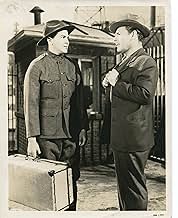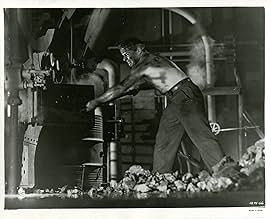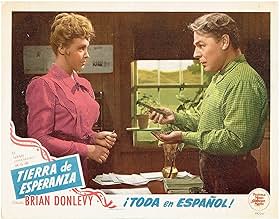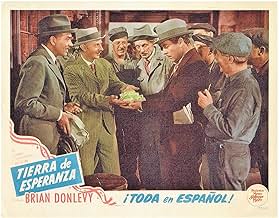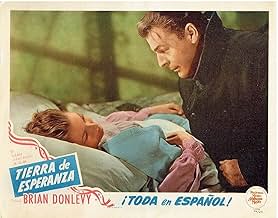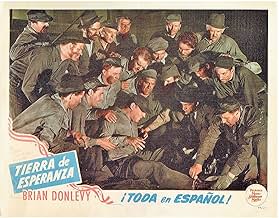CALIFICACIÓN DE IMDb
6.7/10
639
TU CALIFICACIÓN
Stefan Dangos emigra a Estados Unidos y se abre camino desde las minas de hierro y las acerías hasta convertirse en una gran historia de éxito estadounidense como industrial.Stefan Dangos emigra a Estados Unidos y se abre camino desde las minas de hierro y las acerías hasta convertirse en una gran historia de éxito estadounidense como industrial.Stefan Dangos emigra a Estados Unidos y se abre camino desde las minas de hierro y las acerías hasta convertirse en una gran historia de éxito estadounidense como industrial.
- Dirección
- Guionistas
- Elenco
- Premios
- 2 premios ganados en total
Stephen McNally
- Teddy Roosevelt Dangos
- (as Horace McNally)
- …
Ernie Adams
- Man and Dog Act
- (sin créditos)
Erville Alderson
- Olson - Detroit Auto Works Technician
- (sin créditos)
Fred Aldrich
- Assembly Line Worker
- (sin créditos)
Axel Anderson
- Immigrant
- (sin créditos)
King Baggot
- Graduation Ceremony Attendee
- (sin créditos)
Charles Bates
- Teddy Roosevelt Dangos - Age 8
- (sin créditos)
Barbara Bedford
- Hospitable Farm Woman
- (sin créditos)
Arthur Belasco
- Drowsy Miner
- (sin créditos)
Leon Belasco
- Cigar Store Proprietor
- (sin créditos)
Art Berry Sr.
- Customs Man
- (sin créditos)
Anna Marie Biggs
- Girl Soprano
- (sin créditos)
Opiniones destacadas
I saw this movie as a kid of 10 in Port Arthur, Texas, which had four theaters in a four block area. I don't remember all the details, but it was definitely a feel-good film. The protagonist was an Eastern European immigrant whose name was long and hard to pronounce, so he was re-christened Steve Dangos. Steve first got a job iron ore in an "op'm pit". Being bright and ambitious, he later became an automobile manufacturer and, if the movie is to be believed, was the first to build an enclosed sedan. He was proud to be an American (this was at a point in World War II when the outcome was expected but not guaranteed) and he named his sons after Washington and Theodore Roosevelt. He had his share of sorrow when one of the sons was killed in World War I. This was not one of the all-time film classics, but it must have made a great impression on me for the basic plot to have stayed with me for all these 62 years.
As A career merchant seaman on the Great Lake's ore carriers, and working for a large steel maker, I found this movie most interesting and well done. This motion picture contains many historical shots of early lake vessels at the locks in Sault Ste. Marie and docking in Gary, Indiana. The story seems to be based on the life of Andrew Carnegie who was also an immigrant from Scotland. My family came from the Pittsburgh area and were employed with a large steel company, so I can relate well to the plot. Brian Donlevey visited aboard some of our vessels while making this movie in the port of Gary, Indiana. I liked this movie and watch it when I find it advertised to be shown on TV. I would own it if I could buy it because of its historical value..
Wonderful shots of ca 1940 industry. The iron mine and ore docks were beautifully done, the open hearth and rolling mill was also great. Loved the Plymouths re-badged as "Dantons", apparently these were '41 leftovers as passenger car production was halted during the war. But the credits say the airplane factory was Douglas, some of the close ups of the Rosie the riveters may have been Douglas, but surely the B-17 line was at a Boeing plant? Or did Douglas also build B-17s?
But the drama was kind of corny. Not that immigrants didn't or couldn't become industrialists, but I don't think GMs steel turret tops cars could possibly have been invented in a backyard shed. In 1910 an innovative individual might have made a real improvement in auto production; by the thirties this could only have been done by a large industrial firm like GM with millions of dollars and hundreds of engineers.
But the drama was kind of corny. Not that immigrants didn't or couldn't become industrialists, but I don't think GMs steel turret tops cars could possibly have been invented in a backyard shed. In 1910 an innovative individual might have made a real improvement in auto production; by the thirties this could only have been done by a large industrial firm like GM with millions of dollars and hundreds of engineers.
First take note of the date of this movie ( the forties) because we still had the mindset to be grateful and that was a time where people all over the world wanted to immigrate here. Not knowing what to expect, having little or no money and not speaking English they knew if they can get here the rest would come and it did for tens of millions of people. This is displayed quite well in this movie. I enjoyed Brian Donlevy and I kept waiting for him to trip up on his foreign accent but he was too good an actor to do so. This is an every man who only knows hard honest work and because of that does very well winning over people, making a buck, climbing the success ladder and even purchasing a home. Great scenes of family and traditions too. The war enters into the picture with Pearl Harbor and we are introduced to joining the military to defend and fight back as well as Rosie the riveter (women work forces) and what was Americas strongest points i.e. manufacturing and coming together as a nation. We could turn out volume on anything we chose such as planes, ammo, guns, etc. We ended up not only giving and selling planes to help Russia and others but also let many just end up in huge junk yards across the nation after the war ended. America could do no wrong and our main character proves that point over and over through tragedy and triumph. It starts out a little slow but necessary to make the points and then delivers a nice satisfactory viewing for your time and attentions given. Good movie to eat a meal by, have a tasty drink and a leisurely snack or two. Make sure to take note of the automobile industry in its infancy and the designs of the cars too. Also note that they sold cars from orders taken at car show annually. Fascinating bits of little history here and there. Enjoy
Watching this film tonight and for the first time in about 40 years I also was seeing it in color for the first time and made me even more curious as to why no name stars were in the title roles with such an expensive production. From Robert Osborne I learned tonight that Spencer Tracy was originally going to be Steven Danglos instead of Brian Donlevy. Personally I would have waited for Tracy to become available and not because Donlevy gave a bad performance.
Donlevy's role is that of an Eastern European immigrant who starts work at a steel mill and by dint of his own hard work ethic rises to become a captain of industry. Along the way he woos and weds Ann Richards and they have a girl and four boys. A lot of immigrants did it that way and some are still doing it though many are illegal now. Back when we had virtually unlimited immigration because we wanted to grow the country a lot of stories like Donlevy's were possible although few rose to his heights. On both sides of my family that story could be told modified quite a bit.
In the end Donlevy is confronted with of all things labor management problems. He proves as stubborn as people like Henry Ford in that regard. If you remember in Citizen Kane a drunken Joseph Cotten tells off Orson Welles that something called organized labor is coming on the scene and what you gave your employees as largess is now thought of as their rights. Donlevy has the same paternalistic approach.
American Romance is also a tribute to the power of American industry which was growing to what we thought in 1944 as having unlimited potential. It was the backbone of our war effort and the last ten minutes without words show what Donlevy's Steven Danglos was a part of.
For reasons I think that no name star was in the lead, American Romance did not do that well. That's a pity because it's a fine film with wonderful cinematography which I finally saw on a color TV. Nice casting all around with such familiar folks as Walter Abel, John Qualen, and Stephen McNally. I hope TCM broadcasts it again soon.
Donlevy's role is that of an Eastern European immigrant who starts work at a steel mill and by dint of his own hard work ethic rises to become a captain of industry. Along the way he woos and weds Ann Richards and they have a girl and four boys. A lot of immigrants did it that way and some are still doing it though many are illegal now. Back when we had virtually unlimited immigration because we wanted to grow the country a lot of stories like Donlevy's were possible although few rose to his heights. On both sides of my family that story could be told modified quite a bit.
In the end Donlevy is confronted with of all things labor management problems. He proves as stubborn as people like Henry Ford in that regard. If you remember in Citizen Kane a drunken Joseph Cotten tells off Orson Welles that something called organized labor is coming on the scene and what you gave your employees as largess is now thought of as their rights. Donlevy has the same paternalistic approach.
American Romance is also a tribute to the power of American industry which was growing to what we thought in 1944 as having unlimited potential. It was the backbone of our war effort and the last ten minutes without words show what Donlevy's Steven Danglos was a part of.
For reasons I think that no name star was in the lead, American Romance did not do that well. That's a pity because it's a fine film with wonderful cinematography which I finally saw on a color TV. Nice casting all around with such familiar folks as Walter Abel, John Qualen, and Stephen McNally. I hope TCM broadcasts it again soon.
¿Sabías que…?
- TriviaDuring World War II, there were no passenger car assembly lines in operation. As a result, Vidor had to borrow cars from Chrysler, take them apart and re-assemble them in a simulated assembly line. Seen emerging from the factory are 1942 Plymouths with a Danton insignia and hubcaps. These were the last passenger cars manufactured by Chrysler before the World War II shutdown.
- ErroresAs Steve Dangos closes his front door (after arriving home from the board meeting), a hand and lower arm can also be seen closing the door from the outside.
- Versiones alternativasOriginal version premiered at 151 minutes; later cut to 122 minutes.
- Bandas sonorasAmerica, My Country Tis of Thee
(1832) (uncredited)
Music by Lowell Mason, based on the Music by Henry Carey from "God Save the King" (1744)
Played during the opening credits
Reprised at the end
Selecciones populares
Inicia sesión para calificar y agrega a la lista de videos para obtener recomendaciones personalizadas
Detalles
Taquilla
- Presupuesto
- USD 3,000,000 (estimado)
- Tiempo de ejecución2 horas 31 minutos
- Relación de aspecto
- 1.37 : 1
Contribuir a esta página
Sugiere una edición o agrega el contenido que falta

Principales brechas de datos
By what name was Tierra de esperanza (1944) officially released in India in English?
Responda
